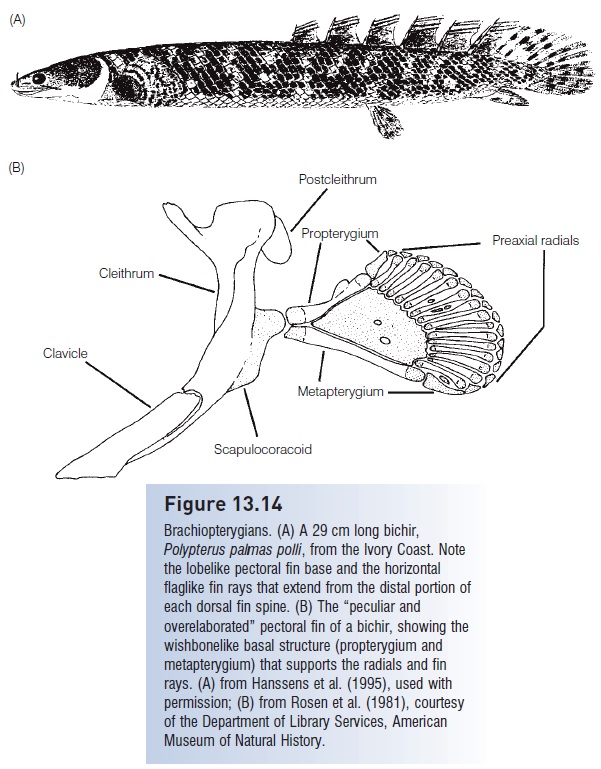Chapter: The Diversity of Fishes: Biology, Evolution, and Ecology: Living representatives of primitive fishes
Cladistian autapomorphic and synapomorphic traits
Cladistian autapomorphic and synapomorphic traits
The bichirs have a remarkable number of autapomorphic (unique, derived) traits. Their median and paired fins are unlike those of any other major taxon. Bichirs are also referred to as “fl agfins” because the 5–18 dorsal finlets each consist of a vertical spine to which are attached horizontal rays, giving them a “fl ag and pole” appearance. In all other ray-finned fishes, the dorsal fin rays emerge as vertical bony elements from the body of the fish. The pectoral fin is lobe-shaped but constructed differently from the lobe fins of lungfishes and crossopterygians, or for that matter, any other fish, living or extinct. The supporting structures of the pectoral fin are shaped like a wishbone with a flat plate (Fig. 13.14B). A. S. Romer, a leader of modern vertebrate paleontology, referred to the polypterid pectoral fin as a “peculiar and overelaborated development” (Romer 1962, p. 198).

Other apparent autapomorphic traits include relatively few and small chromosomes (Denton & Howell 1973); the structure, arrangement, replacement, and differentiation of teeth (Wacker et al. 2001); and possession of only four rather than five gill arches, the fi fth having been lost (Britz & Johnson 2003). And recoil aspiration breathing is performed by no other known extant group.
The placement of cladistians at the base of bony fish phylogeny is justified by a number of derived traits shared with the rest of the Actinopterygii. These characters include egg structure, nuclear DNA-coded genes, Hox-A gene sequences, mitochondrial DNA and amino acid sequences, and cranial skeleton morphology and function (Bartsch 1997; Bartsch & Britz 1997; Venkatesh et al. 2001; Chiuet al. 2004; Kikugawa et al. 2004). These and other synapomorphies make the Cladistia “the sister group of all other actinopterygians” (Nelson 2006, p. 88), rather than a sarcopterygian or a chondrostean. The issue appears to be settled.
Related Topics